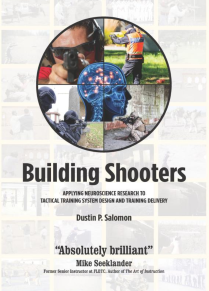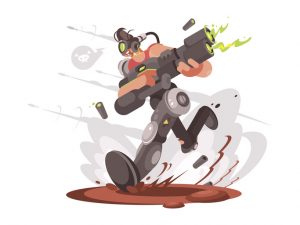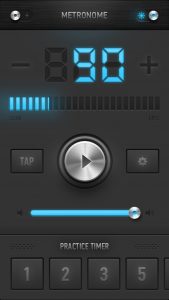People say that you MUST have recoil for firearms training to be effective.
All of my subscribers, students, and clients know that recoil doesn’t matter for first shot speed and accuracy, but what about multi-shot speed and accuracy?
Well, at some speed, you absolutely must do live fire to keep shooting fast, tight groups.
For me, that speed is .3 splits for an 8” target at 30 feet.
When I shoot faster than that after ONLY doing dry fire practice, my groups open up…from about an 8” target at 30 feet to 10-12” at 30 feet.
When I switch from 0% live fire to about 10% live fire, my splits on 8” groups at 30 feet drop down to .2.
.3 splits won’t win any world championships, but .3 splits at 30 feet is great for self-defense applications.
 I credit Dusty Solomon (Building Shooters) with turning me on to the fact that .4 second splits (and hits) are mediocre in the competition world, but are fast enough to effectively stop the threat in the vast majority of self-defense situations.
I credit Dusty Solomon (Building Shooters) with turning me on to the fact that .4 second splits (and hits) are mediocre in the competition world, but are fast enough to effectively stop the threat in the vast majority of self-defense situations.
There’s a system that I use to get this kind of performance with dry fire training…
It’s Rhythm & Tempo.
I guess you could call that 2 things, but they are intertwined.
Here’s what happens…
When you dry fire at a certain pace, it quickly becomes your default speed for live fire.
In fast, multi-shot sequences, the brain oftentimes gets overloaded and there’s not enough conscious bandwidth to pick a speed, so your brain goes with whatever default speed you’ve trained at the most.
If there’s no default speed, the brain usually either picks an erratic tempo or just goes as fast as it can.
So, if you tend to do dry fire reps at a speed that’s faster than what you can run the gun in live fire, your groups are going to open up in live fire.
There’s a lot of value in learning to run the trigger as quickly as possible without disturbing sight alignment.
That’s one of the big benefits of training with Dry Fire Cord.
It helps improve trigger finger isolation so that you internalize and improve how quickly you can run your finger, but you also need to combine that with knowing how quickly you can run the gun before your groups open up.
 Beau Dobozynski from Defensive Mindset Training (Concealed Carry Masters Course) calls the problem of dry firing faster than what you can live fire “laser gunning” because it happens so often with laser training platforms.
Beau Dobozynski from Defensive Mindset Training (Concealed Carry Masters Course) calls the problem of dry firing faster than what you can live fire “laser gunning” because it happens so often with laser training platforms.
It’s REALLY easy to play “laser commando” and shoot super fast multi-shot strings when there’s no recoil to contend with.
Beau gets around the problem by following up all dry fire training with a few live fire reps. But, this isn’t an option for most.
So, how do you get around the problem if you can’t immediately follow up your dry fire practice with live fire?
The answer depends on whether or not you can do fast live fire practice.
Option 1, if you can do live fire first:
Pick a target size and distance, like 4” or 8” at 21 or 30 feet. You may also want to try smaller, closer targets if that works better with your dry fire practice area.
Use a shot timer, and see what pace you can shoot and keep all of your hits on target.

Screenshot of the iOS MetroTimer app
If you have trouble with a rhythmic, steady tempo, consider using a metronome app on your phone, ear buds, and sticking shooting muffs on top of the ear buds. That way, you can hear the metronome telling you what tempo to shoot at.
Once you’ve got your target size, distance, and tempo, use that same target size, distance, and tempo for dry fire practice at home by using a metronome when you dry fire practice multi-shot sequences. In many cases, you can get away with using 1/2 size targets at 1/2 distance, but the effectiveness varies wildly based on vision.
You may want to test a few different combinations. Your splits may be 2x faster at 10 feet than at 30 and it’s important to be able to shift gears depending on the demands of the shot.
Option 2, if you can only do dry fire for now:
If you’ve got any video of you shooting 3 or 5 round rhythmic strings where you know you made your hits, use that tempo, target size, and distance for dry fire.
If you don’t have video, pick a tempo that is slightly slower than what you think you’re shooting right now and do your multi-shot dry fire practice at that tempo.
That may be .5 second splits or it could easily be .9 or 1 second splits, depending on the demands of the shot, the gun you’re shooting, your grip, and your vision speed. Keep in mind that you’ve probably got .1-.2 seconds of “blind” time between shots that you’re not even aware of where your brain limits and/or turns off visual processing…so err towards a slower speed rather than a faster speed.
You can always speed up in live fire if your sights settle early, but it’s much, much harder to slow down in the middle of a multi-shot string.
In addition to using a metronome, you can use songs that have a strong beat that matches the tempo that you want to shoot at. As an example, I use “Kickstart My Heart” sometimes because it starts “slow” and has 3 beats per second. Once you know the tempo you want to shoot at, you can create a playlist by doing a google search like this: “songs with 180 bpm”
If you go with option 2, at some point you want to get to a range where you can figure out what speed is best for you.
It becomes a loop…
Figure out what grip brings your sights back into automatic alignment and how long it takes to happen with live fire,
Practice and refine it with dry fire,
And re-assess and adjust as necessary with live fire.
The goal isn’t to replace live fire…it’s to get you the highest level of performance with the least time and money necessary.
If you want to quickly and dramatically improve first hit speed, stress modulation, faster, smoother reloads, dramatically better trigger control, the speed that you see your sights, and improve your ability to track your sight sin recoil, you can get it as part of Draw Stroke Mastery right now by clicking >HERE<
Questions? Comments? Fire away by commenting below:
2 Comments
Alan
June 28, 2020I may be wrong but I thought I read in an earlier post of yours that strings will allow a semi auto to re rack.
I have two Rugers a Security 9 and an LC9s, the former a hammer fired and the latter a striker.
Am I having a dream ? If not can you elaborate for this wayward soul?
Thanks
Alan
Ox
June 28, 2020Absolutely…check this out: https://dryfiretrainingcards.com/blog/dry-fire-cord/
Leave A Response